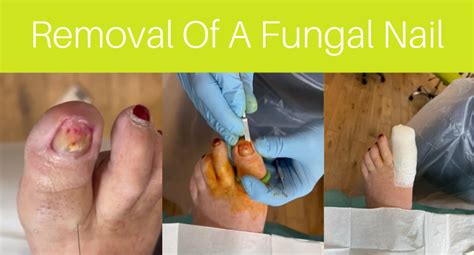Intro
Effective nail fungus removal treatments and home remedies to cure fungal infections, promoting healthy nails through laser therapy, topical creams, and natural remedies like tea tree oil.
Nail fungus, also known as onychomycosis, is a common condition that affects millions of people worldwide. It is characterized by a fungal infection that penetrates the nail and causes a range of symptoms, including thickening, discoloration, and brittleness. If left untreated, nail fungus can lead to more serious complications, such as bacterial infections and permanent damage to the nail. In this article, we will explore the importance of nail fungus removal and the various treatment options available.
The importance of nail fungus removal cannot be overstated. Not only can the condition cause physical discomfort and pain, but it can also have a significant impact on a person's self-esteem and confidence. Nail fungus can be unsightly, causing embarrassment and self-consciousness, especially during the summer months when sandals and open-toed shoes are more common. Furthermore, if left untreated, nail fungus can spread to other parts of the body, such as the skin and other nails, causing further complications.
In addition to the physical and emotional impacts, nail fungus removal is also important for maintaining good overall health. Fungal infections can be a sign of a weakened immune system, and if left untreated, can lead to more serious health problems. By removing the fungal infection, individuals can help to boost their immune system and prevent future infections. With the various treatment options available, individuals can take control of their nail health and prevent the spread of the infection.
Nail Fungus Removal Methods

There are several nail fungus removal methods available, including topical treatments, oral medications, and surgical procedures. Topical treatments, such as creams and ointments, are applied directly to the affected nail and can be effective in treating mild cases of nail fungus. Oral medications, such as antifungal pills, are prescribed for more severe cases and work by targeting the fungal infection from the inside out. Surgical procedures, such as nail removal, are typically reserved for severe cases where the fungal infection has caused significant damage to the nail.
Topical Treatments
Topical treatments are a popular option for nail fungus removal, as they are relatively easy to use and have few side effects. These treatments typically contain ingredients such as tea tree oil, urea, and salicylic acid, which have antifungal and antibacterial properties. To use a topical treatment, individuals simply apply the cream or ointment to the affected nail, usually once or twice a day. It is essential to follow the instructions carefully and use the treatment for the recommended amount of time to ensure effective results.Oral Medications
Oral medications are prescribed for more severe cases of nail fungus and work by targeting the fungal infection from the inside out. These medications, such as terbinafine and itraconazole, are usually taken for several months to ensure that the fungal infection is fully eliminated. While oral medications can be effective, they can also have side effects, such as liver damage and interactions with other medications. It is essential to discuss the potential risks and benefits with a healthcare professional before starting treatment.Surgical Procedures
Surgical procedures, such as nail removal, are typically reserved for severe cases of nail fungus where the fungal infection has caused significant damage to the nail. During the procedure, the affected nail is removed, and the underlying tissue is treated with an antifungal medication. While surgical procedures can be effective, they can also be painful and may require several weeks of recovery time.Natural Remedies for Nail Fungus Removal

In addition to medical treatments, there are several natural remedies that can help to remove nail fungus. These remedies, such as tea tree oil, garlic, and vinegar, have antifungal and antibacterial properties that can help to combat the fungal infection. To use a natural remedy, individuals can apply the treatment directly to the affected nail, usually once or twice a day.
Tea Tree Oil
Tea tree oil is a popular natural remedy for nail fungus removal, as it has antifungal and antibacterial properties. To use tea tree oil, individuals can apply a few drops to the affected nail, usually once or twice a day. It is essential to dilute the oil with a carrier oil, such as coconut or olive oil, to avoid irritating the skin.Garlic
Garlic is another natural remedy that can help to remove nail fungus. The antifungal and antibacterial properties of garlic can help to combat the fungal infection, reducing the risk of further complications. To use garlic, individuals can crush a clove and apply it directly to the affected nail, usually once or twice a day.Vinegar
Vinegar is a natural remedy that can help to remove nail fungus by changing the pH of the nail environment. The acidity of the vinegar can help to inhibit the growth of the fungal infection, reducing the risk of further complications. To use vinegar, individuals can soak the affected nail in a solution of equal parts water and vinegar, usually once or twice a day.Prevention of Nail Fungus

Preventing nail fungus is essential to maintaining good nail health. There are several steps that individuals can take to reduce the risk of developing nail fungus, including keeping the nails clean and dry, avoiding sharing personal care items, and wearing shoes that fit properly. By taking these steps, individuals can reduce the risk of developing nail fungus and prevent the spread of the infection.
Keeping the Nails Clean and Dry
Keeping the nails clean and dry is essential to preventing nail fungus. Individuals should wash their hands and feet regularly, especially after exercising or engaging in activities that cause sweating. It is also essential to dry the nails thoroughly, especially between the toes, to prevent moisture from accumulating.Avoiding Sharing Personal Care Items
Avoiding sharing personal care items, such as nail clippers and files, can help to prevent the spread of nail fungus. Individuals should use their own personal care items and avoid sharing them with others, even if they appear to be clean.Wearing Shoes that Fit Properly
Wearing shoes that fit properly can help to prevent nail fungus by reducing the risk of moisture accumulation. Individuals should wear shoes that are breathable and fit properly, avoiding shoes that are too tight or too loose.Treatment Options for Nail Fungus

There are several treatment options available for nail fungus, including topical treatments, oral medications, and surgical procedures. The choice of treatment will depend on the severity of the infection and the individual's overall health. It is essential to consult with a healthcare professional to determine the best course of treatment.
Topical Treatments
Topical treatments are a popular option for nail fungus, as they are relatively easy to use and have few side effects. These treatments typically contain ingredients such as tea tree oil, urea, and salicylic acid, which have antifungal and antibacterial properties.Oral Medications
Oral medications are prescribed for more severe cases of nail fungus and work by targeting the fungal infection from the inside out. These medications, such as terbinafine and itraconazole, are usually taken for several months to ensure that the fungal infection is fully eliminated.Surgical Procedures
Surgical procedures, such as nail removal, are typically reserved for severe cases of nail fungus where the fungal infection has caused significant damage to the nail. During the procedure, the affected nail is removed, and the underlying tissue is treated with an antifungal medication.Conclusion and Final Thoughts

In conclusion, nail fungus removal is an essential step in maintaining good nail health. With the various treatment options available, individuals can take control of their nail health and prevent the spread of the infection. By understanding the causes and symptoms of nail fungus, individuals can take steps to prevent the condition and seek treatment if necessary. It is essential to consult with a healthcare professional to determine the best course of treatment and to prevent further complications.
We invite you to share your thoughts and experiences with nail fungus removal in the comments below. Have you tried any of the treatment options mentioned in this article? What were your results? By sharing your story, you can help others who may be struggling with nail fungus.
What are the symptoms of nail fungus?
+The symptoms of nail fungus include thickening, discoloration, and brittleness of the nail. In severe cases, the nail may become painful and inflamed.
How is nail fungus diagnosed?
+Nail fungus is typically diagnosed through a physical examination and laboratory tests, such as a nail scraping or biopsy.
What are the treatment options for nail fungus?
+The treatment options for nail fungus include topical treatments, oral medications, and surgical procedures. The choice of treatment will depend on the severity of the infection and the individual's overall health.
